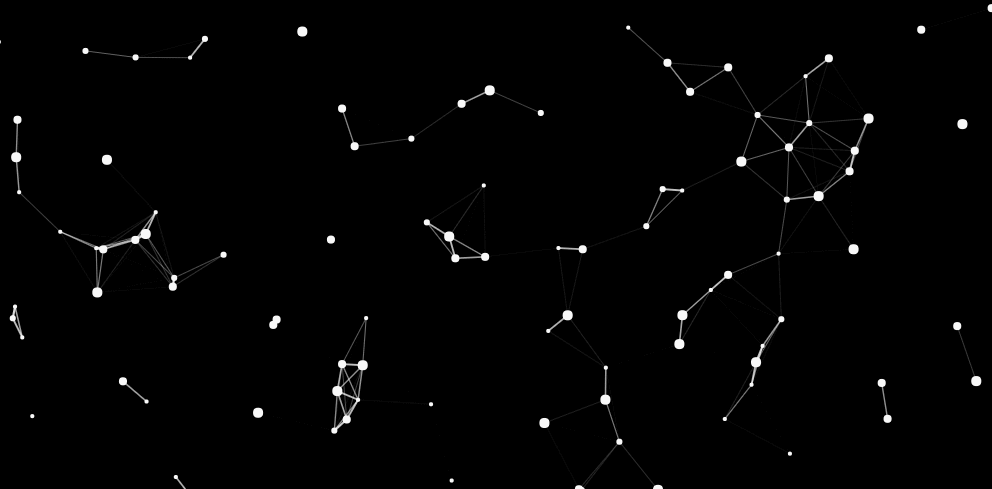
这个动画在很早之前就见过,当时就没迷住了。最近在学canavs动画,动手实现了一下。代码在这里。展示效果在这里。
这属于粒子系统的一种,粒子系统就是需要管理一堆粒子嘛,动画实现的关键在于,遍历这些粒子,并更新它们的位置。
粒子
每个粒子都需要包含自己的横纵坐标想x、y,半径r,各分量上的加速度ax、ay,速度vx、vy,还有所属的场景owner,这里的粒子加速度均为0。
// 父类
class Sprite { constructor(args={}) { this.x = args.x || 0; this.y = args.y || 0; this.vx = args.vx || 0; this.vy = args.vy || 0; this.ax = args.ax || 0; this.ay = args.ay || 0; } moveTo(x, y) { this.x = x; this.y = y; } update() { this.vx += this.ax; this.vy += this.ay; this.x += this.vx; this.y += this.vy; } render() { return true; } }
// 粒子 class Particle extends Sprite{ constructor(args) { super(args); this.owner = args.owner; this.r = args.r || 10; this.color = args.color || 'black'; this.adjust = this.adjust.bind(this); } update() { super.update(); if(this.x < this.r || this.x + this.r > this.owner.w) { this.vx *= -1; this.x = this.adjust(0, this.owner.w, this.x); } if(this.y < this.r || this.y + this.r > this.owner.h) { this.vy *= -1; this.y = this.adjust(0, this.owner.h, this.y); } } render(ctx) { ctx.beginPath(); ctx.fillStyle = this.color; ctx.arc(this.x, this.y, this.r, 0, Math.PI * 2, false); ctx.closePath(); ctx.fill(); } adjust(min, max, v) { return v > max ? max : (v < min ? min : v); } }
父类的update()中用于改变对象的坐标,particle类的update()在调用了父类的update方法之后,进行边界检测。
边界检测
边界检测属于碰撞检测的一种。在改变粒子位置之后,对粒子进行边界检测,防止粒子逃出canvas哦。本例中的粒子是圆形的,可以通过粒子中心点与边界之间的距离进行判断,若小于粒子自身半径,则对粒子坐标进行修正,确保粒子始终位于canvas中。
/*
* this.x 粒子横坐标
* this.y 粒子纵坐标
* this.r 粒子半径
* this.owner.w 粒子所在场景(canvas)宽度
* this.owner.h 粒子所在场景(canvas)高度
*/
if(this.x < this.r || this.x + this.r > this.owner.w) {
this.vx *= -1;
this.x = this.adjust(0, this.owner.w, this.x);
}
if(this.y < this.r || this.y + this.r > this.owner.h) {
this.vy *= -1;
this.y = this.adjust(0, this.owner.h, this.y);
}
当粒子坐标超出边界时,使用adjust()重置粒子坐标,确保粒子在canvas内。
adjust(min, max, v) {
return v > max ? max : (v < min ? min : v);
}
粒子系统
粒子系统就是对粒子进行管理的。
this.nodes = []; // 保存粒子 this.edges = []; // 粒子成对保存,用于连线
存储edges时,使用双层循环,内循环n的从i + 1开始,避免重复保存。
for(let i = 0, len = this.nodes.length; i < len; ++i) { for(let n = i + 1; n < len; ++n) { this.edges.push({ from: this.nodes[i], to: this.nodes[n] }) } }
计算两个粒子之间的距离。
lengthOfEdge(edge) { let w = Math.abs(edge.from.x - edge.to.x), h = Math.abs(edge.from.y - edge.to.y); return Math.sqrt(w * w + h * h); }
粒子间距离越短,连线越粗、越深。
this.ctx.lineWidth = (1 - l / this.threshold) * 2.5; this.ctx.globalAlpha = 1 - l / this.threshold;
超出一定距离就不连线。
let l = this.lengthOfEdge(edge); if(l > this.threshold) { return; }
鼠标事件
这里为了与用户有互动,加入了鼠标事件。当鼠标在canvas内移动时,第一个粒子nodes[0]的跟随鼠标移动。当鼠标静止或者在canvas外时,则按照原来的速度进行移动。
mouserEnter(e) { this.mouse = this.nodes[0]; } mouseMove(e) { this.mouse.x = e.offsetX; this.mouse.y = e.offsetY; } mouseLeave() { this.mouse = null; }
至于动画的更新,建议使用requestAnimationFrame()。